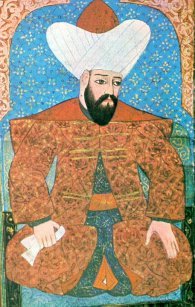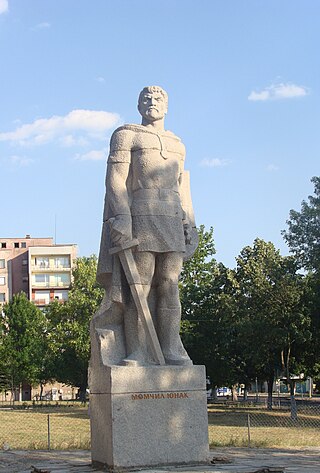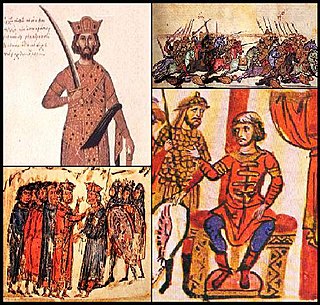
Andronikos III Palaiologos, commonly Latinized as Andronicus III Palaeologus, was the Byzantine emperor from 1328 to 1341. He was the son of Michael IX Palaiologos and Rita of Armenia. He was proclaimed co-emperor in his youth, before 1313, and in April 1321 he rebelled against his grandfather, Andronikos II Palaiologos. He was formally crowned co-emperor in February 1325, before ousting his grandfather outright and becoming sole emperor on 24 May 1328.

Orhan Ghazi was the second bey of the Ottoman Beylik from 1323/4 to 1362. He was born in Söğüt, as the son of Osman I.

John VI Kantakouzenos or Cantacuzene was a Byzantine Greek nobleman, statesman, and general. He served as grand domestic under Andronikos III Palaiologos and regent for John V Palaiologos before reigning as Byzantine emperor in his own right from 1347 to 1354. Deposed by his former ward, he was forced to retire to a monastery under the name Joasaph Christodoulos and spent the remainder of his life as a monk and historian. At age 90 or 91 at his death, he was the longest-lived of the Roman emperors.

Ivan Alexander, also sometimes Anglicized as John Alexander, ruled as Emperor (Tsar) of Bulgaria from 1331 to 1371, during the Second Bulgarian Empire. The date of his birth is unknown. He died on 17 February 1371. The long reign of Ivan Alexander is considered a transitional period in Bulgarian medieval history. Ivan Alexander began his rule by dealing with internal problems and external threats from Bulgaria's neighbours, the Byzantine Empire and Serbia, as well as leading his empire into a period of economic recovery and cultural and religious renaissance.

Momchil was a 14th-century Bulgarian brigand and local ruler. Initially a member of a bandit gang in the borderlands of Bulgaria, Byzantium and Serbia, Momchil was recruited by the Byzantines as a mercenary. Through his opportunistic involvement in the Byzantine civil war of 1341–1347, where he played the various sides against each other, he became ruler of a large area in the Rhodopes and western Thrace.

The Aydinids or Aydinid dynasty, also known as the Principality of Aydin and Beylik of Aydin, was one of the Anatolian beyliks and famous for its seaborne raiding.

The Byzantine–Bulgarian wars were a series of conflicts fought between the Byzantine Empire and Bulgaria which began after the Bulgars conquered parts of the Balkan peninsula after 680 AD. The Byzantine and First Bulgarian Empire continued to clash over the next century with variable success, until the Bulgarians, led by Krum, inflicted a series of crushing defeats on the Byzantines. After Krum died in 814, his son Omurtag negotiated a thirty-year peace treaty. Simeon I had multiple successful campaigns against the Byzantines during his rule from 893 to 927. His son Peter I negotiated another long-lasting peace treaty. His rule was followed by a period of decline of the Bulgarian state.

The Bulgarian–Ottoman wars were fought between the kingdoms remaining from the disintegrating Second Bulgarian Empire, and the Ottoman Empire, in the second half of the 14th century. The wars resulted with the collapse and subordination of the Bulgarian Empire, and effectively came to an end with the Ottoman conquest of Tarnovo in July 1393, although other Bulgarian states held out slightly longer, such as the Tsardom of Vidin until 1396 and the Despotate of Dobruja until 1411. As a result of the wars the Ottoman Empire greatly expanded its territory on the Balkan peninsula, stretching from the Danube to the Aegean Sea.
Year 1345 (MCCCXLV) was a common year starting on Saturday of the Julian calendar. It was a year in the 14th century, in the midst of a period in human history often referred to as the Late Middle Ages.

The Battle of Stephaniana was a small-scale battle between the forces of the Medieval Serbian Kingdom and the Emirate of Aydin, allies of Byzantine emperor John VI Kantakouzenos. It was the first battle between the Serbs and Turks, as an earlier battle in Gallipoli was fought between troops sent by King Milutin and Turcopole Halil Pasha (1312).
Irene Palaiologina was the eldest daughter of Byzantine emperor Michael VIII Palaiologos and empress Theodora Palaiologina, and empress consort of Ivan Asen III of Bulgaria.

Pirot Fortress or Momchilov grad is situated in Pirot, Serbia. It was built in the 14th century by Bulgarian brigand and local ruler Momchil. In 1344, the regency concluded a further alliance with Bulgaria, which required the surrender of Philippopolis (Plovdiv) and nine other towns in northern Thrace along the river Evros. Nevertheless, after their occupation, Ivan Alexander refrained from direct action against John VI Kantakouzenos' forces operating in southern and eastern Thrace. At the same time, Momchil, a former brigand whom Kantakouzenos had entrusted with control over the Merope (region) in the Rhodope mountains, switched over to the regency. It was supposed to serve as a defense against the Turks along the ancient Roman road called Via Militaris which connected Belgrade to Constantinople.
The Byzantine civil war of 1341–1347, sometimes referred to as the Second Palaiologan Civil War, was a conflict that broke out in the Byzantine Empire after the death of Andronikos III Palaiologos over the guardianship of his nine-year-old son and heir, John V Palaiologos. It pitted on the one hand Andronikos III's chief minister, John VI Kantakouzenos, and on the other a regency headed by the Empress-Dowager Anna of Savoy, the Patriarch of Constantinople John XIV Kalekas, and the megas doux Alexios Apokaukos. The war polarized Byzantine society along class lines, with the aristocracy backing Kantakouzenos and the lower and middle classes supporting the regency. To a lesser extent, the conflict acquired religious overtones; Byzantium was embroiled in the Hesychast controversy, and adherence to the mystical doctrine of Hesychasm was often equated with support for Kantakouzenos.
Vojihna or Vojin of Drama, was a Serbian nobleman that rose through the ranks and became one of the most acclaimed military commanders (voivode) and dukes of Stephen Uroš IV Dušan of Serbia during the Serbian Kingdom and Empire (1331–71), he was titled Caesar, hence, he is mostly known as Caesar Vojihna. He held the region of Drama.
The Byzantine civil war of 1352–1357 was an armed conflict resulting from and following the Byzantine civil war of 1341–1347. The war pitted Byzantine emperor John V Palaiologos against John VI Kantakouzenos and his eldest son Matthew Kantakouzenos. John V emerged victorious as the sole emperor of the Byzantine Empire, but the destruction brought about by the civil war left the Byzantine state in ruins.
In the 14th-century Balkans, Merope was a subregion of Thrace in modern northern Greece and southern Bulgaria. The region lay in the western and middle part of the Rhodope Mountains.
Michael Senachereim Monomachos was a high-ranking Byzantine official, who served as governor of Thessalonica and Thessaly. He reached the high rank of megas konostaulos.

Gradislav Borilović was a Serbian magnate in the service of Stefan Uroš III Dečanski and Stefan Dušan, having the titles of vojvoda (general), kaznac, and tepčija. Gradislav led the Serbian army that fought the Ottoman emirate at the Battle of Demotika in October 1352. The battle was fought between the allies of the two rival Byzantine Emperors, John V Palaiologos and John VI Kantakouzenos, and it was the first major battle of the Ottomans on European soil, which ended in a Serbian defeat. Greek sources spoke of Gradislav as "truly one of the most respectable among the Serbs".

The Battle of Demotika was a battle that took place during the Byzantine civil war which began in 1352 between the forces of the Ottoman Empire and those of the Serbian Empire and Second Bulgarian Empire.

Anastasiopolis-Peritheorion is an archaeological site located in northern Greece, southeast of the village of Amaxades in the Rhodope regional unit in Western Thrace. Parts of the fortification walls of the ancient city of Anastasiopolis and Peritheorion are still visible. It is unclear whether these are two different cities or a single one that has been renamed in the meantime. The ancient city was an important port on the Aegean Sea and station on the Via Egnatia.













